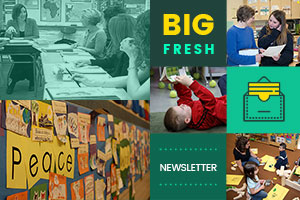Having a child is like getting a tattoo . . . on your face. You better be committed.
Elizabeth Gilbert
Last night, I was cleaning up some things in the kitchen before heading to bed. I opened up our refrigerator and when I did, a bottle of raspberry vinaigrette salad dressing fell out. The bottle hit the floor, broke open, and made a huge mess. As I looked down in frustration, I had an epiphany.
Maybe I should explain. Our kids have chores to do each day. My six-year-old son, Eli, helps clean off the table after dinner. When he put the salad dressing away last night, he didn’t quite get it in the shelf on the door securely. When I opened the door later in the evening, the dressing fell out and made the mess.
My first reaction was to get upset. But then it hit me. My son was just trying to help. He was doing his best, even though the results weren’t great.
Educators experience something similar with behaviors, test scores, and projects. It’s easy to get upset when efforts don’t match what we want to see in results. In order to be most effective, we have to learn to manage our reactions. How we respond to results, both good and bad, is often more important than the results themselves.
If you’re like me, the tendency is to get upset, frantic, or frustrated when things don’t work out like you think they should. I’ve found that the key for me to manage my reaction is to focus on the goal of what we’re trying to accomplish. It takes the emotion out of it. When I’m able to focus on, “What are we trying to accomplish here?” it helps me stay focused on what’s important.
I also try to keep a soft spot. After the millisecond of frustration with Eli, I thought about how much I love my son, about how much he tries to please me and do his best. I couldn’t be frustrated. I happily cleaned up the mess. But we often lose that soft spot with our students. The great challenge and opportunity of teaching is that we get to see our kids at their best and worst.
Taking the time to get to know our students is a critical aspect in keeping that soft spot in our hearts for them. We can do that by using passing periods to chat with students, inviting students into our classrooms for lunch, and attending student extracurricular activities.
Most important, we can choose to believe the best about our students. It is a choice. Believing the best about our students allows us to clean up the messes and help them learn how to do better next time.
This week we consider literacy homework, plus more as always. Enjoy!
David Robertson
Contributor, Choice Literacy
David Robertson is the chief academic officer at the Warsaw (Indiana) Community Schools.

There may be few literacy homework assignments more despised by families than the dreaded reading log. Gigi McAllister proposes some alternatives, and explains how she keeps families in the loop on reading progress.
Cathy Mere suggests some strategies for working with struggling students who read very little at home.
We hope you’ll make our online course program part of your personal improvement plan this spring. Instructors include Ruth Ayres, Katherine Sokolowski, Dana Murphy and many others. Topics in the self-paced classes include student research projects, smarter reading conferences, and better coaching cycles. Members receive discounts of 20-40% on course fees, and nonmembers receive three-month trial memberships to the website.

New members-only content is added each week to the Choice Literacy website. If you’re not yet a member, click here to explore membership options.
Ruth Ayres encourages her son to use the web for assistance when doing homework, and then has to ponder whether what she is advocating qualifies as cheating.
Just reading. Pure, unadulterated reading. That’s the reading homework that matters most in the long run. Stephanie Affinito explains why.
In this week’s video, Bitsy Parks makes the home-school connection with first grader Grace early in the year as she writes about her birthday party.
In an encore video, Karen Terlecky’s fifth-grade students share what they learned from their word study homework.

Lead Literacy now has a new home as the Leaders Lounge at Choice Literacy. We’ll be posting the new content updates here in the Leaders Lounge section of the Big Fresh newsletter.
Melanie Meehan explores research findings on homework, and provides a series of prompts for thinking through with teachers how to revise homework practices to be more relevant and helpful for students and families.
In this quick video, Jennifer Schwanke talks about the importance of school leaders building a sense among teachers and families of how literacy is the foundation for all learning in classrooms.
New PD2Go: This workshop is designed to help participants assess the quality of their family outreach, consider new initiatives, and assist families with communication. In the video, Gigi McAllister gives a brief explanation of how her thinking on goal setting has changed, as well as the ways in which she uses student goals to connect with parents. In the handout, Max Brand shares strategies for helping parents talk with students.
Melanie Quinn shares the process of coming up with a schoolwide homework policy that aligns beliefs and practices across grade levels.
Quote It:
Don’t discount disgruntled people. When they feel committed and supported, dissatisfaction energizes them to find new solutions to old problems.
Adam Grant
That’s all for this week!



